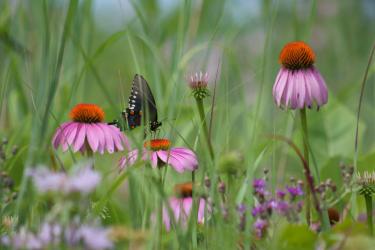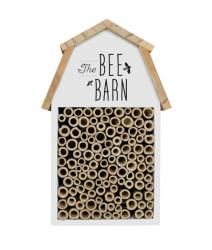All About Bees
All potential stings aside, bees pack a powerful environmental punch. Though you may not realize it, bees are responsible for pollinating one in every three bites of food we eat! They’re the tiny, behind-the-scenes workers promoting the health and prosperity of countless ecosystems. While so important in our everyday lives, the future of bees is in peril; according to the Center for Biological Diversity, “more than half of North America’s 4,000 native bee species are in decline with one in every species at risk of extinction.” There are several simple steps you can take in your own garden to encourage the local bee population’s growth and well-being.
Plant for Pollinators
Whether your garden sprawls across acres or is limited to window boxes, there are opportunities to plant for pollinators, especially bees, in even the smallest of spaces. The best way to naturally support your local bee population is to plant Missouri natives that these species are attracted to for pollination, aiming to have several natives to make your bloom season range continuously from spring to fall. You can also opt to plant in clusters; this essentially gives bees a target to find, allowing them to move from flower to flower easily. When choosing a site for these natives, select one removed from wind with at least partial sun near water if possible! After a long day of pollinating, bees need a drink, too.
Gimme Shelter
Although honey bees live in hives, many wild bees and Mason bees take shelter elsewhere. If you’re interested in giving them a little extra help, adding a bee box to your yard or garden (especially near wildflowers and a water source) gives these bees a place to rest and nest. You can also allow material from dead branches and logs to remain as nesting sites, as wild bees take refuge in dead trees and branches, weedy hedgerows and old animal burrows. Ground-nesting bees can only properly burrow in the ground without mulch, so consider leaving parts of your garden bare for ground nesters.
The Impact of Pesticides
Many people turn to insecticides to eliminate pests; however, these insecticides have also been greatly harming the bee population, killing off species vital to natural plant pollination and survival. Consider using non-chemical management methods on your lawn and garden where you can, including introducing beneficial insects, such as spiders, yellow lady beetles, wheel bugs and praying mantises. (A more
comprehensive list can be found on the Missouri Botanical Garden’s website). You can introduce these beneficial insects through planting natives that attract them! If you MUST use pesticides, please read all labels and directions carefully to limit the risk of harming beneficial insects and bees.
Flowering Missouri Natives
Information provided by the Missouri Botanical Garden
Purple coneflower: This long-blooming, showy ornamental tolerates a wide range of growing conditions from full sun to part shade. Many species of insects are highly attracted to the flowers, including bees, butterflies and beetles. The flowers are often subtly fragrant. Finches are particularly fond of the seeds, harvesting them in summer, fall and winter.
Joe Pye weed: These attractive mauve pink flowers spring up from July to September, typically lasting about one month. The nectar is highly attractive to bees, butterflies, skippers and moths.
Common boneset: This underutilized perennial wildflower bears spreading clusters of fragrant white flowers in late summer to early fall, often lasting for a month or more. Either nectar or pollen attracts many types of pollinators, including bees, butterflies, flies, wasps and beetles. Tolerant of flooded conditions for short periods of time, common boneset can make an excellent choice for rain gardens.
Wild bergamot: This mid-summer bloomer flowers for about one month. The nectar is particularly attractive to bees, butterflies and ruby-throated hummingbirds. The caterpillars of several moth species feed on the foliage. Other Missouri native monardas that are also attractive to pollinators include spotted bee balm (Monarda punctata) and Eastern bee balm (Monarda bradburiana).
New England aster: An important source of nectar for Monarch butterflies migrating south to their wintering grounds in Mexico, New England aster flowers also provide either nectar or pollen to many other butterflies and a variety of bee species.











